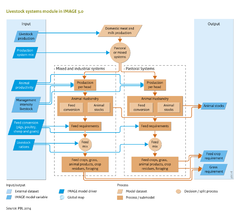Livestock systems/Description: Difference between revisions
Jump to navigation
Jump to search
No edit summary |
m (Text replace - "Agricultural economy and forestry" to "Agricultural economy") |
||
| Line 5: | Line 5: | ||
==Livestock== | ==Livestock== | ||
IMAGE distinguishes five types of livestock: beef, dairy cattle (large ruminants), the category sheep & goats (small ruminants), pigs, and poultry (monogastrics). The numbers of animals and the proportion per production system are calculated from data on domestic livestock production per region provided by the agro-economic model MAGNET ([[Agricultural economy | IMAGE distinguishes five types of livestock: beef, dairy cattle (large ruminants), the category sheep & goats (small ruminants), pigs, and poultry (monogastrics). The numbers of animals and the proportion per production system are calculated from data on domestic livestock production per region provided by the agro-economic model MAGNET ([[Agricultural economy]]). The number of animals in each of the five livestock types is calculated from the total production per region and the characteristics of the livestock systems in that region. | ||
Stocks of dairy cows (POP) per country and world region are obtained from total milk production (PROD) and milk production per animal (MPH){{FormulaAndTableTemplate|Formula1_LS}}Animal stocks per region of beef cattle, pigs, and sheep and goats are obtained from production and carcass weight (CW) and off-take rate (OR):{{FormulaAndTableTemplate|Formula2_LS}}Historical data on milk production per cow, off-take rate, and carcass weight are obtained from statistics, and values for future years will depend on the scenario selected. | Stocks of dairy cows (POP) per country and world region are obtained from total milk production (PROD) and milk production per animal (MPH){{FormulaAndTableTemplate|Formula1_LS}}Animal stocks per region of beef cattle, pigs, and sheep and goats are obtained from production and carcass weight (CW) and off-take rate (OR):{{FormulaAndTableTemplate|Formula2_LS}}Historical data on milk production per cow, off-take rate, and carcass weight are obtained from statistics, and values for future years will depend on the scenario selected. | ||
| Line 25: | Line 25: | ||
In pastoral ruminant production systems, the feed is almost entirely grass except in developing regions where foraging constitutes a larger but variable proportion of the total feed. Pigs and poultry are fed feed crops and by-products, crop residues and fodder. Since these animals are mainly farmed in mixed systems, the contribution of feed crops and residues to the total feed in these systems is much higher than in pastoral systems. | In pastoral ruminant production systems, the feed is almost entirely grass except in developing regions where foraging constitutes a larger but variable proportion of the total feed. Pigs and poultry are fed feed crops and by-products, crop residues and fodder. Since these animals are mainly farmed in mixed systems, the contribution of feed crops and residues to the total feed in these systems is much higher than in pastoral systems. | ||
The required feed crop production per animal is calculated from feed rations, and this information is incorporated into the agro-economic model ([[Agricultural economy | The required feed crop production per animal is calculated from feed rations, and this information is incorporated into the agro-economic model ([[Agricultural economy]]). The proportion of grass in feed rations determines total grass consumption, which is used to compute the grassland area per world region, based on grazing intensity ([[Agricultural economy]] and [[Agricultural systems]]). | ||
==Scenario definition== | ==Scenario definition== | ||
A scenario includes assumptions on milk production per animal for dairy cattle, carcass weight and off-take rate for beef cattle, pigs, poultry, sheep and goats, and feed conversion rates (FCR) for pigs, poultry, sheep and goats. The changes in these parameters are generally based on the scenario, and on the economic growth scenario. | A scenario includes assumptions on milk production per animal for dairy cattle, carcass weight and off-take rate for beef cattle, pigs, poultry, sheep and goats, and feed conversion rates (FCR) for pigs, poultry, sheep and goats. The changes in these parameters are generally based on the scenario, and on the economic growth scenario. | ||
}} | }} | ||
Revision as of 18:28, 16 May 2014
Parts of Livestock systems/Description
| Component is implemented in: |
| Components: |
| Related IMAGE components |
| Projects/Applications |
|
| Models/Databases |
| Key publications |
| References |
